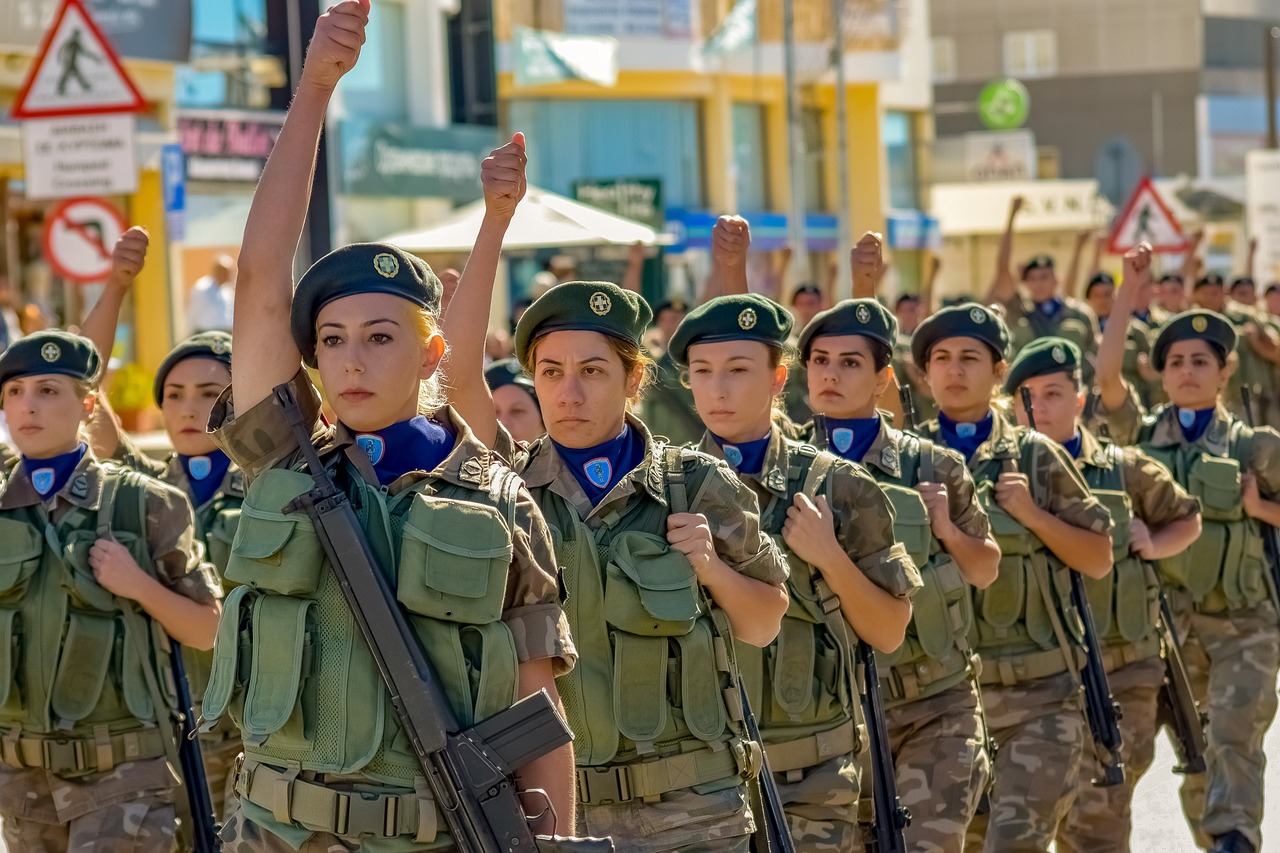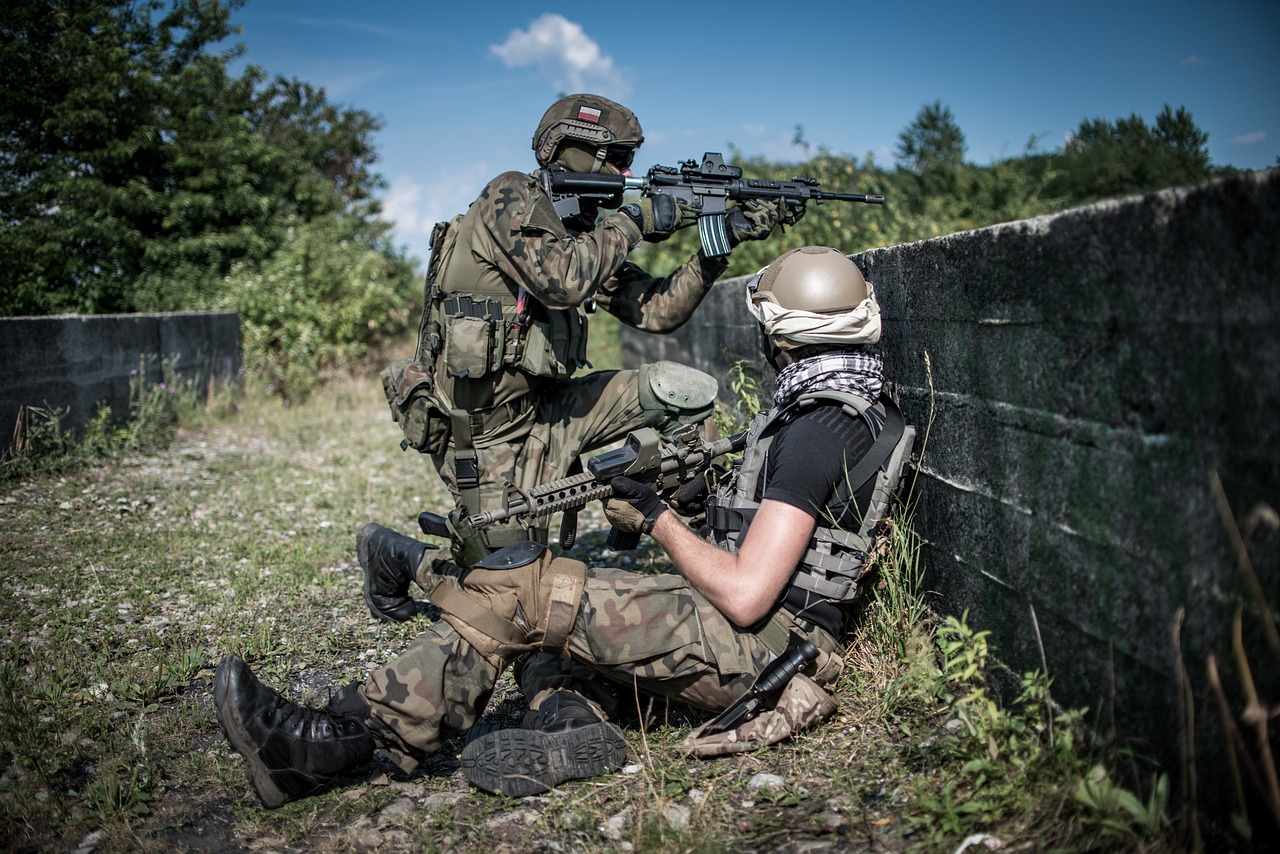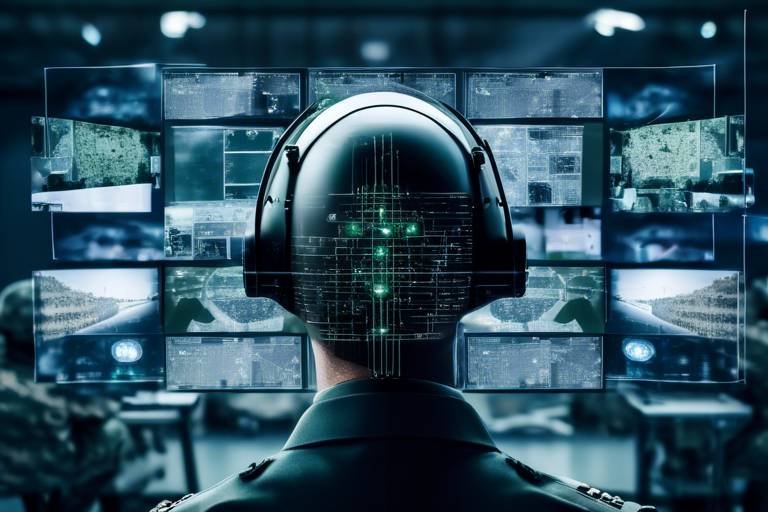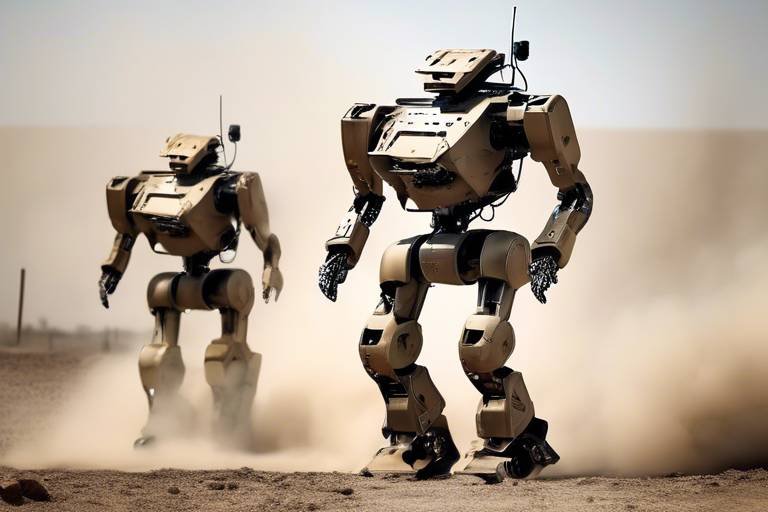How AI-Powered Systems are Revolutionizing Military Training
In recent years, the military has witnessed a significant transformation in training methodologies, primarily due to the integration of artificial intelligence (AI). This technological advancement is not merely a trend; it represents a paradigm shift in how soldiers are prepared for the complexities of modern warfare. Imagine a training environment where every soldier receives personalized instruction tailored to their unique strengths and weaknesses. This is not a distant dream but a reality facilitated by AI-powered systems.
AI technologies are being woven into the fabric of military training programs, creating an ecosystem that enhances learning experiences and simulates real-world scenarios. Soldiers can now engage in training exercises that mimic the unpredictability of combat situations, allowing them to hone their skills in a safe yet challenging environment. With AI, the military can analyze performance data to refine training strategies continuously, ensuring that every soldier is combat-ready.
The core of this revolution lies in the ability of AI to provide adaptive learning experiences. Traditional training methods often follow a one-size-fits-all approach, which can leave some soldiers underprepared while others may feel unchallenged. AI changes the game by utilizing algorithms that assess individual performance, enabling the development of customized training programs. This personalized approach not only addresses specific weaknesses but also enhances overall readiness for diverse combat situations.
Furthermore, the integration of AI in military training encompasses the use of simulations and virtual environments. These AI-driven simulations create realistic scenarios that allow military personnel to practice complex maneuvers without the risks associated with live training exercises. Imagine a soldier navigating a virtual battlefield, making split-second decisions that could mean the difference between success and failure. This kind of immersive training experience is invaluable in preparing soldiers for the challenges they will face in the field.
However, the journey toward fully integrating AI into military training is not without its challenges. Data privacy and security are paramount concerns, as the use of AI raises questions about the protection of sensitive military information. Military organizations must implement robust cybersecurity measures to safeguard this data from potential breaches. Additionally, there can be resistance to change from personnel accustomed to traditional training methods. Overcoming this resistance requires effective change management strategies and education about the tangible benefits of AI-enhanced training.
Looking ahead, the future of military training promises even more advancements in AI technologies. As these systems evolve, they will lead to increasingly immersive, effective, and efficient training solutions. The goal is to prepare soldiers not just for the battles of today but for the complexities of modern warfare that lie ahead. With AI, the military stands on the brink of a training revolution that could redefine operational readiness and effectiveness.
- What are the main benefits of using AI in military training?
AI enhances training efficiency, provides personalized learning experiences, and allows for real-time performance analysis, leading to continuous improvement. - How does AI ensure personalized training?
AI algorithms assess individual soldier performance, creating tailored training programs that address specific strengths and weaknesses. - What challenges does the military face in implementing AI?
Challenges include data security concerns, the need for significant investment, and potential resistance from personnel accustomed to traditional methods. - What does the future hold for AI in military training?
The future will likely see more immersive and effective training solutions, preparing soldiers for the complexities of modern warfare.

The Role of AI in Military Training
As the landscape of warfare evolves, so too must the training methods used to prepare military personnel. Enter artificial intelligence (AI), a game-changing technology that is rapidly becoming integral to military training programs worldwide. AI technologies are not just a fad; they are reshaping the way soldiers learn, adapt, and prepare for real-world challenges. By providing tailored learning experiences and simulating real-world scenarios, AI enhances soldiers' skills and decision-making abilities in unprecedented ways.
Imagine a training environment where every soldier receives a personalized curriculum, designed specifically for their strengths and weaknesses. This is not science fiction; it's the reality that AI brings to military training. AI systems analyze vast amounts of data, including performance metrics, to create individualized training plans. This means that instead of a one-size-fits-all approach, each soldier can focus on areas where they need the most improvement, making their training more efficient and effective.
Moreover, AI can simulate complex combat scenarios that would be difficult, dangerous, or even impossible to recreate in real life. These simulations allow soldiers to practice their skills in a controlled environment, where they can make mistakes without the real-world consequences. For instance, an AI-driven simulation might recreate a challenging urban combat situation, complete with virtual civilians and unpredictable enemy behavior. Soldiers can engage in these scenarios repeatedly, honing their skills until they are second nature.
In addition to enhancing the training experience, AI also provides valuable insights into a soldier's performance. During training exercises, AI systems can track metrics such as reaction time, decision-making speed, and accuracy. This data is analyzed in real-time, allowing instructors to provide immediate feedback. Instead of waiting for a debriefing session, soldiers can learn from their mistakes on the spot, refining their techniques and improving their performance continuously.
Furthermore, AI's ability to adapt to the training environment is remarkable. With adaptive learning systems, training content can be modified in real-time based on a soldier's progress. If a soldier struggles with a particular skill, the AI can adjust the training materials to focus more on that area, ensuring that they remain engaged and retain critical knowledge. This level of personalization is a significant leap forward from traditional training methods, where adjustments might be slow and cumbersome.
In summary, the role of AI in military training is multifaceted and transformative. It not only enhances the way soldiers learn but also prepares them for the complexities of modern warfare. By integrating AI technologies into training programs, military organizations can ensure that their personnel are better equipped to face the challenges of the battlefield.
- What are the main benefits of using AI in military training? AI enhances training efficiency, personalizes learning experiences, and provides immediate feedback, leading to improved performance.
- How does AI create personalized training programs? AI analyzes individual soldier performance data to identify weaknesses and tailor training content accordingly.
- What types of simulations does AI offer? AI can create realistic combat scenarios, including urban environments and unpredictable enemy actions, allowing soldiers to practice without real-world risks.
- Are there challenges in implementing AI in military training? Yes, challenges include data security concerns, the need for significant investment, and potential resistance from personnel accustomed to traditional methods.

Benefits of AI-Enhanced Training
AI-powered training systems are not just a passing trend; they're reshaping the landscape of military training in profound ways. Imagine a training program that adapts to the unique needs of each soldier, offering personalized learning paths that enhance skills and readiness. This is the reality that AI brings to the table. By leveraging advanced algorithms and data analytics, military training can now be more efficient, effective, and tailored to individual needs than ever before.
One of the most significant advantages of AI-enhanced training is the ability to analyze vast amounts of performance data. This means that commanders and training officers can gain insights into how each soldier is performing and where improvements can be made. For instance, if a soldier struggles with a specific tactical maneuver, AI can identify this weakness and recommend targeted exercises to help them improve. This level of customization is like having a personal coach who knows exactly what you need to work on and when.
Moreover, AI systems can facilitate adaptive learning experiences. These systems adjust the training content in real-time based on the soldier's progress. This dynamic approach ensures that soldiers remain engaged and challenged, preventing the common pitfalls of boredom and disengagement that can occur in traditional training environments. For example, if a soldier masters a particular skill quickly, the AI can introduce more complex scenarios to keep pushing their limits.
Another compelling benefit is the immediate feedback provided by AI systems during training exercises. Traditional training methods often involve waiting for assessments and feedback, which can slow down the learning process. With AI, soldiers receive instant insights into their performance, allowing them to learn from their mistakes on the spot. This rapid feedback loop is crucial in high-stakes environments where quick decision-making is essential.
Furthermore, AI-driven simulations create incredibly realistic training environments. These simulations allow military personnel to practice complex scenarios without the risks associated with live training exercises. Imagine training for a combat situation where you can experience the chaos of battle, make mistakes, and learn from them—all without any real-world consequences. This safe yet immersive training is a game-changer, providing soldiers with the experience they need to excel in actual combat situations.
In summary, the benefits of AI-enhanced training are multi-faceted and transformative. From personalized learning experiences to real-time feedback and realistic simulations, AI is paving the way for a new era of military training that prioritizes efficiency and effectiveness. As we look to the future, it’s clear that the integration of AI will not only enhance operational readiness but also redefine what it means to be prepared for the complexities of modern warfare.
- What are the main advantages of AI in military training? AI offers personalized learning experiences, real-time feedback, and realistic simulations, enhancing overall training effectiveness.
- How does AI customize training for individual soldiers? AI algorithms assess performance data to create tailored training programs that address specific weaknesses.
- Are there any risks associated with using AI in military training? Yes, concerns include data privacy, security, and potential resistance from personnel accustomed to traditional training methods.
- What is the future of AI in military training? The future will likely involve more immersive and efficient training solutions that prepare soldiers for complex combat scenarios.

Personalized Learning Experiences
In the realm of military training, personalization is becoming a game-changer. Imagine walking into a training facility where the program adapts to your unique skills and weaknesses, almost like having a personal trainer who knows exactly what you need to improve. AI algorithms are at the forefront of this transformation, analyzing a soldier's performance in real-time and creating customized training programs that cater to individual needs. This means that no two training experiences are the same, allowing each soldier to focus on what matters most for their personal development.
For instance, if a soldier struggles with marksmanship, the AI can identify this weakness and adjust the training regimen accordingly, offering more drills focused on precision shooting. Conversely, if another soldier excels in tactical maneuvers but lacks in communication skills, the system will emphasize teamwork exercises that enhance those abilities. This tailored approach not only boosts confidence but also ensures that every soldier is as prepared as possible for the challenges they may face on the battlefield.
Moreover, the integration of personalized learning experiences is not just about addressing weaknesses; it’s about maximizing strengths. By identifying a soldier’s unique capabilities, AI can create advanced training scenarios that push them to excel further, fostering a culture of continuous improvement. This kind of targeted training is akin to a tailored suit—crafted to fit perfectly and enhance the wearer’s best features.
In addition to performance tracking, the feedback loop provided by AI enhances the learning experience. Soldiers receive immediate insights into their performance, allowing them to make adjustments on the fly. This instant feedback is crucial, as it enables them to learn from mistakes in real-time, rather than waiting for a post-exercise debrief, which can often be too late to make a significant impact.
To sum it up, personalized learning experiences powered by AI not only make training more efficient but also more engaging. The ability to adapt to individual needs ensures that every soldier is equipped with the skills necessary to thrive in diverse combat situations. As military training continues to evolve, it’s clear that personalization will play a vital role in shaping the future of operational readiness.
- How does AI personalize military training? AI analyzes individual performance metrics to create customized training programs that focus on each soldier's strengths and weaknesses.
- What are the benefits of personalized training? Personalized training enhances engagement, boosts confidence, and ensures that soldiers are better prepared for real-world challenges.
- Can AI provide feedback during training? Yes, AI systems offer immediate feedback, allowing soldiers to learn from their mistakes in real-time.
- Is personalized training more effective than traditional methods? Personalized training has been shown to improve performance outcomes by tailoring the learning experience to individual needs.

Adaptive Learning Systems
Adaptive learning systems are at the forefront of revolutionizing military training, providing a tailored approach that caters to the unique needs of each soldier. Imagine stepping into a training environment that evolves in real-time, responding to your strengths and weaknesses as you progress. This is the essence of adaptive learning—where the training adapts to you, rather than the other way around. Such systems utilize sophisticated algorithms to assess performance metrics, ensuring that every soldier receives the most effective training possible.
One of the most compelling aspects of adaptive learning systems is their ability to create a dynamic training experience. For instance, if a soldier struggles with a particular combat maneuver, the system can instantly modify the training module to focus more on that skill. This not only enhances the soldier's proficiency but also boosts their confidence, as they see tangible improvements in their abilities. Moreover, this personalized approach can significantly reduce training time, allowing soldiers to achieve readiness more quickly than traditional methods.
In a typical training scenario, adaptive learning systems might analyze data such as:
- Reaction times during drills
- Accuracy in simulated combat
- Decision-making speed in high-pressure situations
By continuously evaluating these factors, the system can present targeted exercises that challenge the soldier just enough to promote growth without causing frustration. This balance is crucial in maintaining engagement and motivation, which are key to effective learning.
Furthermore, adaptive learning systems are designed to be user-friendly, making them accessible even to those who may not be tech-savvy. The interface typically features intuitive controls and clear feedback mechanisms, allowing soldiers to focus on their training rather than grappling with complex technology. This ease of use ensures that the integration of AI into training programs is smooth and effective, fostering an environment where soldiers can thrive.
As we look to the future, the potential for adaptive learning systems in military training is immense. With advancements in AI and machine learning, these systems will only become more sophisticated, offering even deeper insights into individual performance and learning styles. This evolution will pave the way for a new era of military readiness, where every soldier is equipped with the skills and knowledge necessary to excel in the complexities of modern warfare.
Q1: What are adaptive learning systems?
A1: Adaptive learning systems are training technologies that adjust the content and pace of learning based on an individual’s performance and needs, providing a personalized training experience.
Q2: How do these systems benefit military training?
A2: They enhance efficiency by tailoring training to individual soldiers, allowing for quicker skill acquisition and improved readiness for diverse combat situations.
Q3: Are adaptive learning systems user-friendly?
A3: Yes, these systems are designed to be intuitive, ensuring that soldiers can focus on training rather than struggling with technology.
Q4: What kind of data do adaptive learning systems analyze?
A4: They analyze various performance metrics, including reaction times, accuracy, and decision-making speed, to tailor training programs effectively.

Feedback and Assessment
In the realm of military training, are crucial components that can significantly impact a soldier's performance. Traditional training methods often rely on delayed feedback, where instructors provide comments after exercises have concluded. This can lead to missed opportunities for immediate improvement. However, with the integration of AI-powered systems, soldiers can now receive real-time feedback during training exercises, which is a game-changer. Imagine playing a video game where the system instantly tells you what you did right or wrong, allowing you to adjust your strategy on the fly. That’s precisely what AI does for military training!
AI systems analyze various performance metrics, such as reaction times, accuracy, and decision-making processes, providing soldiers with instant insights into their actions. This immediate feedback loop not only enhances learning but also fosters a culture of continuous improvement. Instead of waiting for a debriefing session, soldiers can make adjustments in real-time, honing their skills more effectively than ever before. For instance, if a soldier makes a tactical error during a simulation, the AI can highlight the mistake and suggest alternative strategies, allowing for a more dynamic learning environment.
Moreover, the data collected from these assessments can be used to create comprehensive reports that track a soldier's progress over time. This data-driven approach enables military trainers to identify trends and patterns in performance, ensuring that training programs are tailored to meet the specific needs of each individual. For example, if a soldier consistently struggles with a particular skill, the training regimen can be adjusted to provide additional focus on that area. This level of personalization is something traditional methods simply cannot achieve.
Additionally, the AI systems can facilitate peer assessments, where soldiers can provide feedback to one another based on standardized criteria. This not only builds camaraderie but also encourages a deeper understanding of the skills being practiced. Soldiers can learn from each other's experiences, sharing insights that might not be captured by an instructor alone. In essence, AI transforms feedback from a one-way street into a collaborative highway of learning.
As military training continues to evolve, the role of feedback and assessment will undoubtedly become increasingly sophisticated. The combination of AI technology and human expertise has the potential to create a training environment that is not only more efficient but also more engaging. With these advancements, soldiers will be better prepared to face the challenges of modern warfare, equipped with the skills and knowledge necessary to succeed on the battlefield.
- How does AI provide real-time feedback in military training?
AI systems analyze performance data during training exercises, allowing soldiers to receive immediate insights into their actions, which helps them adjust their techniques on the spot. - What are the benefits of personalized training programs?
Personalized training programs address specific weaknesses in soldiers, ensuring that each individual receives the support they need to improve their skills effectively. - Can AI systems replace traditional training methods?
While AI enhances training, it is not meant to replace traditional methods entirely. Instead, it complements them, providing a more dynamic and effective learning experience. - What challenges exist in implementing AI in military training?
Challenges include data privacy concerns, the need for significant investment, and potential resistance from personnel accustomed to traditional training methods.

Simulations and Virtual Environments
In the realm of military training, are game-changers. Imagine stepping into a world where you can face a variety of combat situations without ever leaving a training facility. That's the power of AI-driven simulations! These advanced systems create realistic scenarios that mimic the complexities of actual battlefields, allowing soldiers to hone their skills in a safe yet challenging environment.
One of the most significant advantages of these simulations is the ability to practice high-stakes decision-making under pressure. Soldiers can engage in virtual missions that replicate real-world conditions, complete with unpredictable variables that they might encounter in the field. This exposure helps them develop critical thinking and quick-response skills, which are essential for survival and success in combat.
Moreover, the immersive nature of virtual environments allows for a level of training that traditional methods simply can't match. For instance, soldiers can train in diverse terrains—whether it’s urban landscapes, dense forests, or arid deserts—without the logistical challenges of real-world exercises. This adaptability ensures that military personnel are prepared for any scenario they might face.
Another exciting aspect of AI simulations is their ability to incorporate multiplayer capabilities. Soldiers can train alongside their peers in real-time, fostering teamwork and communication skills that are vital on the battlefield. These interactions can be further enhanced by AI algorithms that analyze each participant's performance, providing tailored feedback to improve individual and group dynamics.
However, it's essential to recognize that while these virtual environments offer numerous benefits, they also require significant investment in technology and training. The infrastructure to support such advanced simulations can be costly, and ensuring that personnel are adequately trained to use these systems is crucial for maximizing their effectiveness. Nevertheless, the potential benefits far outweigh the challenges, paving the way for a new era in military training.
- What are AI-driven simulations? AI-driven simulations are virtual training environments that replicate real-world combat scenarios, allowing soldiers to practice skills and decision-making in a safe setting.
- How do simulations enhance training? They provide immersive experiences that enable soldiers to engage in realistic scenarios, improving their critical thinking and response times.
- Are there any downsides to using simulations? While beneficial, implementing these systems requires significant investment and training to ensure personnel can effectively utilize the technology.
- Can simulations replace traditional training methods? No, simulations are designed to complement traditional training, providing additional layers of preparation for soldiers.

Challenges of Implementing AI in Training
While the integration of AI technologies into military training programs brings a wave of exciting possibilities, it is not without its challenges. One of the most pressing issues is the concern surrounding data privacy and security. As military training increasingly relies on data-driven insights, the protection of sensitive information becomes paramount. Imagine a scenario where critical training data is compromised; the implications could be catastrophic, not just for individual soldiers but for national security as a whole. Therefore, establishing robust cybersecurity measures is essential to safeguard this information from potential breaches.
Another significant hurdle is the resistance to change that can often be observed within military ranks. Many personnel may feel comfortable with traditional training methodologies, viewing them as tried and true. This reluctance can create a barrier to the adoption of AI technologies. Overcoming this resistance requires not just effective change management strategies but also comprehensive education about the benefits of AI-enhanced training. It’s crucial to communicate that AI is not here to replace human expertise but to augment it, providing soldiers with tools that can enhance their skills and decision-making abilities.
Moreover, the financial investment required to implement AI systems can be daunting. Developing, deploying, and maintaining advanced AI technologies necessitates significant resources, which may not always be readily available. Budget constraints can slow the pace of innovation, leaving military training programs at risk of falling behind in a rapidly evolving technological landscape. It’s essential for military organizations to weigh the long-term benefits of AI against the initial costs, ensuring that they can secure the funding needed to harness its full potential.
In addition to these challenges, there is also the potential for technological dependency. As soldiers become accustomed to AI-driven training environments, there is a risk that they may rely too heavily on technology, potentially diminishing their ability to perform in scenarios where AI support is unavailable. Striking a balance between leveraging AI's capabilities and maintaining core competencies is crucial for developing well-rounded military personnel.
Overall, while the challenges of implementing AI in military training are significant, they are not insurmountable. With a proactive approach to addressing data security, fostering a culture of acceptance, securing funding, and ensuring that human skills remain at the forefront, military organizations can successfully navigate this transformative landscape.
- What are the main challenges of implementing AI in military training?
The main challenges include data privacy and security, resistance to change from personnel, financial investment requirements, and the risk of technological dependency. - How can military organizations overcome resistance to AI technologies?
Effective change management and comprehensive education about the benefits of AI-enhanced training are essential to overcome resistance. - What role does data security play in AI training?
Data security is crucial as it protects sensitive military information from potential breaches, ensuring the integrity of training programs. - Is financial investment a significant barrier to AI implementation?
Yes, the financial investment required for developing and maintaining AI technologies can be a significant barrier to implementation.

Data Privacy and Security
In the rapidly evolving landscape of military training, the integration of AI technologies brings with it a host of benefits, but it also raises significant concerns regarding . As military organizations increasingly rely on AI to analyze performance data and tailor training programs, the sensitive nature of the information being processed cannot be overlooked. Imagine the potential fallout if classified data were to fall into the wrong hands; the implications could be catastrophic, not just for individual soldiers but for national security as a whole.
To mitigate these risks, military training programs must implement robust cybersecurity measures. This includes employing advanced encryption techniques, regular security audits, and strict access controls to ensure that only authorized personnel can access sensitive information. Additionally, establishing a culture of security awareness among military personnel is crucial. Soldiers and trainers alike must be educated on best practices for data handling, recognizing potential threats, and understanding the importance of maintaining confidentiality.
Furthermore, the use of AI in training necessitates compliance with various regulations and standards governing data protection. For example, the General Data Protection Regulation (GDPR) in Europe sets stringent guidelines on how personal data should be collected, processed, and stored. Military organizations must ensure that their AI systems are designed to comply with such regulations, which can often be a complex and resource-intensive process.
Moreover, the challenge of data privacy extends beyond just protecting information from external threats. Internal security is equally important. With multiple stakeholders involved in military training—from software developers to trainers—there's a need for clear protocols to prevent unauthorized access or misuse of data. Establishing a strong governance framework can help in delineating roles and responsibilities, ensuring that everyone understands their part in maintaining data integrity.
In summary, while the potential of AI in military training is immense, the associated challenges of data privacy and security cannot be ignored. By prioritizing these aspects, military organizations can harness the power of AI while safeguarding sensitive information. The path forward involves not only technological solutions but also a commitment to fostering a culture of security awareness and compliance.
- What are the main data privacy concerns related to AI in military training?
The primary concerns include unauthorized access to sensitive information, compliance with data protection regulations, and the potential for data breaches. - How can military organizations ensure data security when using AI?
Implementing robust cybersecurity measures, conducting regular audits, and fostering a culture of security awareness among personnel are essential steps. - What regulations must military organizations comply with regarding data privacy?
Organizations must adhere to regulations such as the General Data Protection Regulation (GDPR) and other relevant national and international standards.

Resistance to Change
When it comes to integrating AI technologies into military training, one of the most significant hurdles is the from personnel accustomed to traditional methods. Change can be daunting, especially in an environment where established practices have been honed over years, sometimes decades. Just think about it: if you’ve been using a particular strategy that has worked well, why would you want to switch to something that feels untested and unfamiliar? This mindset is prevalent among many military professionals who are hesitant to embrace the new wave of AI-enhanced training.
Moreover, the military culture often values discipline and structure, which can create a reluctance to deviate from traditional training methods. Soldiers may feel that AI systems lack the human touch necessary for effective training, believing that real-life experiences and mentorship from seasoned veterans are irreplaceable. This perspective highlights a critical challenge: bridging the gap between innovative technology and the deeply ingrained practices of military training.
To address this resistance, it's essential to implement a comprehensive change management strategy. This can include:
- Education and Training: Providing detailed workshops and training sessions that showcase the benefits of AI technologies can help demystify the tools and demonstrate their effectiveness.
- Involvement in the Process: Engaging military personnel in the development and implementation phases of AI systems can foster a sense of ownership and reduce apprehension.
- Success Stories: Sharing case studies and examples of successful AI integration in other military branches or organizations can serve as a powerful motivator for change.
In addition, addressing the emotional aspect of change is crucial. Many soldiers may feel a sense of loss or fear that AI could replace their roles. It’s important to communicate that AI is not a substitute for human judgment and experience but rather a tool that can enhance their capabilities. By framing AI as a partner in their training, we can help alleviate fears and encourage a more open mindset towards adopting these innovations.
Ultimately, overcoming resistance to change requires patience, understanding, and a commitment to demonstrating the long-term benefits of AI-enhanced training. As military personnel witness the positive impacts on their performance and operational readiness, the transition to AI-powered systems will become not just acceptable but desirable.
- What are the main benefits of AI in military training?
AI enhances military training by providing personalized learning experiences, real-time feedback, and realistic simulations that prepare soldiers for complex scenarios.
- How can the military overcome resistance to AI integration?
By implementing effective change management strategies, including education, involvement in the process, and sharing success stories, the military can foster acceptance of AI technologies.
- Are there security concerns with using AI in military training?
Yes, there are significant concerns regarding data privacy and security. Robust cybersecurity measures are essential to protect sensitive military information.

The Future of AI in Military Training
The future of military training is poised for a groundbreaking transformation, largely driven by advancements in artificial intelligence. As we look ahead, it becomes evident that AI technologies will not only enhance the effectiveness of training programs but also redefine how soldiers prepare for the complexities of modern warfare. Imagine a world where training is not just a routine but a dynamic experience that evolves with each soldier's needs. This is the promise that AI holds.
One of the most exciting prospects is the development of immersive training environments. Using AI, military training can leverage virtual reality (VR) and augmented reality (AR)
Moreover, AI can facilitate predictive analytics in training programs. By analyzing vast amounts of data from previous training exercises, AI systems can identify patterns and predict outcomes. This means that training can be tailored not just to individual soldier performance but also to anticipate the challenges they might face in future missions. With this foresight, military organizations can prepare their personnel more effectively, ensuring they are ready for any scenario. Another significant advancement is the use of collaborative AI systems. These systems can enable soldiers to train together in virtual environments, regardless of their physical location. Imagine a unit spread across different bases, yet they can engage in joint exercises, strategizing and executing plans as if they were on the same field. This level of collaboration can enhance team cohesion and improve communication skills, which are vital in high-stakes situations. However, the integration of AI in military training is not without its challenges. As we embrace these technologies, we must also consider the ethical implications and the need for robust cybersecurity measures. Protecting sensitive data will be paramount, as any breach could compromise not only training outcomes but also national security. Military organizations will need to invest significantly in cybersecurity to safeguard their AI systems. In conclusion, the future of AI in military training is bright and filled with potential. As technology continues to evolve, so too will the methods we use to train our soldiers. By embracing AI, we can create more effective, engaging, and adaptive training environments that prepare our military personnel for the challenges of tomorrow. The journey is just beginning, and the possibilities are limitless. AI plays a crucial role in military training by providing tailored learning experiences and simulating real-world scenarios. It enhances soldiers' skills and decision-making abilities, making training more effective and relevant to modern warfare. AI-enhanced training offers numerous benefits, including increased efficiency, personalized learning paths, and the ability to analyze performance data for continuous improvement. This leads to better preparedness and operational readiness for soldiers. Personalized learning in AI training systems involves algorithms that assess individual soldier performance. This allows for customized training programs that target specific weaknesses, ensuring that each soldier receives the support they need to excel. Adaptive learning systems are technologies that adjust training content in real-time based on a soldier's progress. This ensures optimal engagement and retention of critical skills, making the training process more effective and enjoyable. AI systems offer immediate feedback during training exercises, helping soldiers learn from their mistakes and refine their techniques. This instant feedback loop is much more efficient than traditional methods, allowing for quicker skill acquisition. Challenges include data privacy and security concerns, the need for significant investment in technology, and potential resistance from personnel who prefer traditional training methods. Addressing these issues is crucial for successful integration. The use of AI in military training raises concerns about protecting sensitive data. Robust cybersecurity measures are necessary to safeguard information from potential breaches, ensuring that military operations remain secure. Overcoming resistance requires effective change management strategies and education about the benefits of AI-enhanced training. Demonstrating success stories and providing training on new technologies can help ease the transition. The future of military training is likely to see further advancements in AI technologies, leading to more immersive, effective, and efficient training solutions. This evolution will better prepare soldiers for the complexities of modern warfare.
Frequently Asked Questions



















